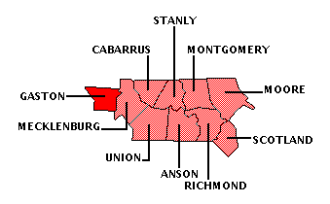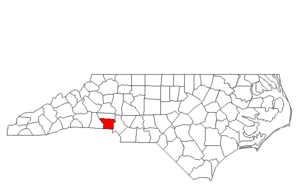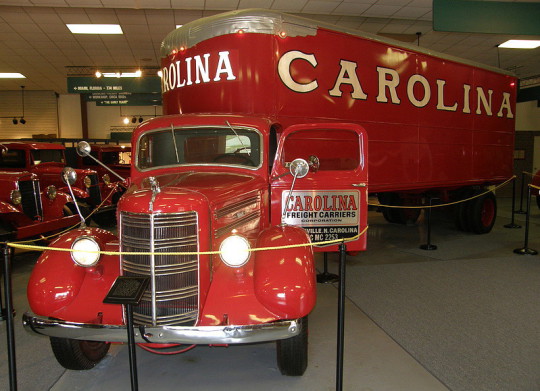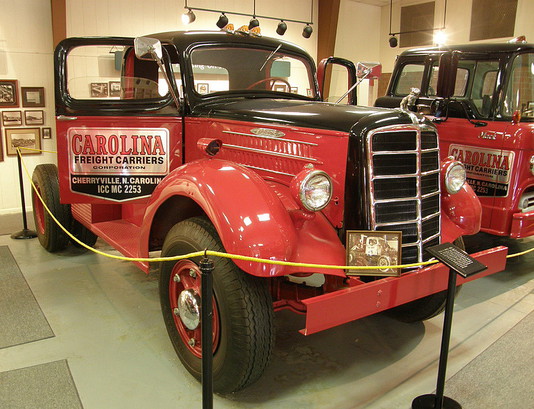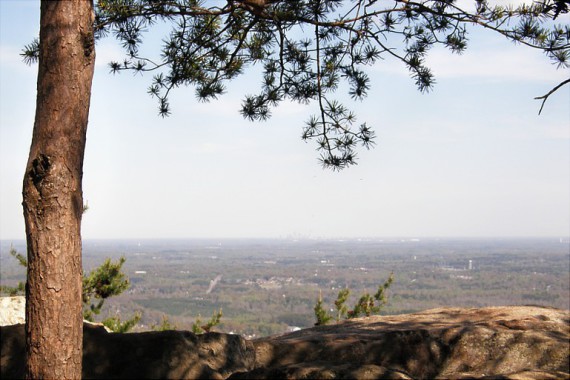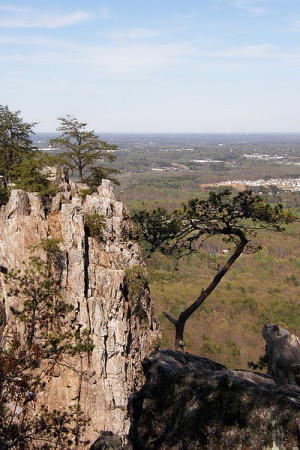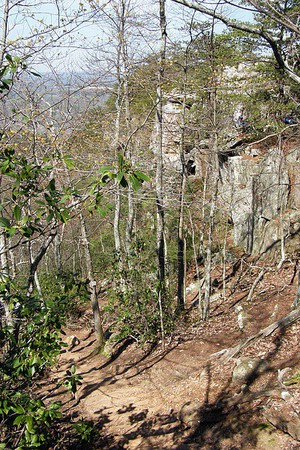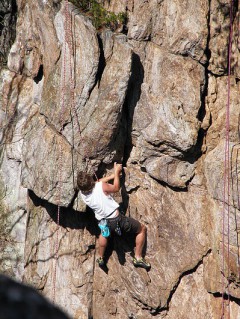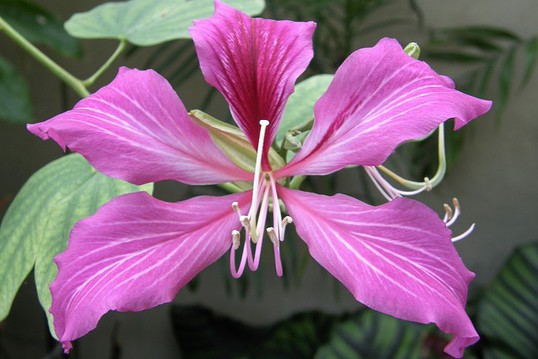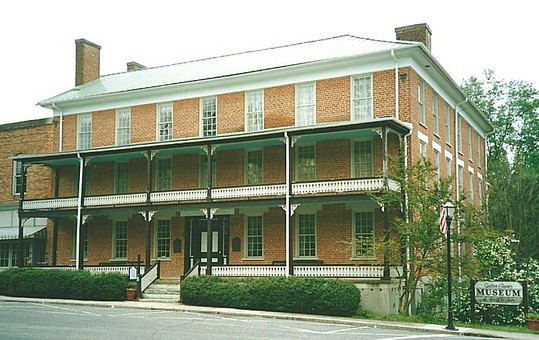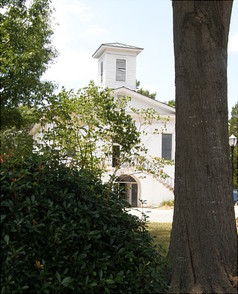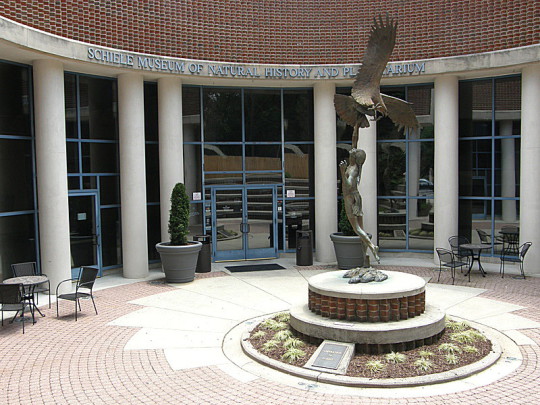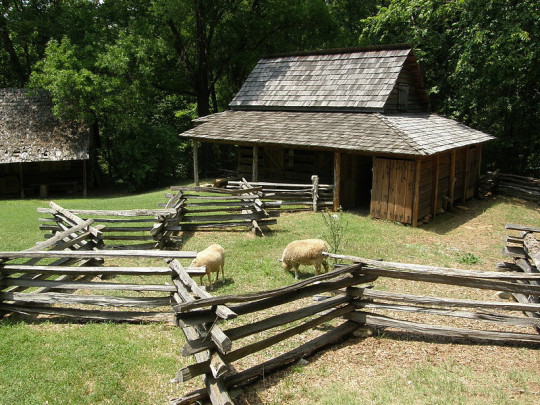GASTON COUNTY
Scroll down this page or click on specific site name to view features on the following Gaston County attractions/points of interest:
C. Grier Beam Truck Museum, Crowders Mountain State Park, Daniel Stowe Botanical Garden, Gaston County Museum of Art and History, Schiele Museum of Natural History
Fast facts about Gaston County:
Created in 1846, the county is named for William Gaston, US congressman and NC Supreme Court justice.
The county seat is Gastonia. Other communities include Belmont, Bessemer City, Cherryville, Cramerton, Dallas, High Shoals, Lowell, McAdenville, Mount Holly, Ranlo, Spencer Mountain, and Stanley.
Gaston County’s land area is 356.21 square miles; the population in the 2010 census was 206,086.
It is worth noting that McAdenville has earned a reputation as “Christmas Town, USA” because of its impressive annual display of Yuletide illumination.
Cherryville
Located in the original gas station where Carolina Freight had its beginnings, the C. Grier Beam Truck Museum opened in 1982 as part of the company’s 50th anniversary. The adjacent, 7,700-square-foot building displays seven decades of vintage trucks and related memorabilia. The business had an inauspicious start in 1932, when Charles Grier Beam drove a truckload of goods to Florida. Not wanting to return with an empty truck, he purchased some fresh produce to carry back to North Carolina, paying for the fruits and vegetables with a bad check, gambling that he could sell the produce and deposit the money before the check reached his hometown bank. The gamble paid off, and Beam invested his earnings in a truck of his own. Success did not come easily or quickly at the height of the Great Depression, but success did, indeed, come. By the time Beam retired from the business, Carolina Freight was among the nation's top ten carriers, with annual sales topping $650 million. Although Carolina Freight was acquired by Arkansas Best Company in 1995, the Cherryville museum keeps alive the history of the NC-based carrier. Hours are 10-3 Thursday through Saturday. Admission is free. 704-435-3072
West of Gastonia
Although located only a few miles west of Gastonia, Crowders Mountain State Park remains an unknown to many area residents. A young man visiting the park for the first time, stopping for a moment to catch his breath while making the steep ascent to the mountaintop, was overheard telling a friend, “It’s this close to Charlotte, but I’ve lived here more than ten years and I never knew anything about it.” As this gentleman discovered, however, this rugged state park offers a pleasant diversion from city life.
If Crowders Mountain and Kings Pinnacle, with elevations of 1,625 feet and 1,705 feet, respectively, were located in the Blue Ridge or Smoky Mountain ranges of western North Carolina, they would be mere pebbles among the boulders, scarcely warranting notice. As every real estate agent soon learns, however, location is everything. Rising up where they do in the heart of Gaston County, these peaks tower 800 feet above the surrounding countryside, so they do, indeed, command attention. Classified as kyanite-quartzite monadocks, Crowders Mountain and Kings Pinnacle have been around for a few million years. The state park is of considerably more recent origin, having opened in 1974. Interestingly, the summit of Crowders Mountain was not included within the boundaries of the park at its inception, and remained outside park limits until 1977. In 1987, additional acreage including Kings Pinnacle was acquired, and most recently, a 2,000-acre segment was added that allowed Crowders Mountain State Park to connect with Kings Mountain National Military Park and Kings Mountain State Park in South Carolina.
There’s no question that the park’s main attractions are the magnificent views awaiting those who make an ascent up Crowders Mountain or Kings Pinnacle. From the park office and visitor center, two major trails head off in opposite directions. Both are equally popular and offer similar experiences – strenuous uphill climbing along heavily-shaded footpaths. Along the way, hikers will find a variety of plant life – mountain laurel and dogwood are especially plentiful – and at the peaks, Virginia pines are found in abundance. In other locales, these hardy trees often reach heights of 60-to-90 feet. Here, the pines are usually only 2-to-10 feet tall. At the summit, it’s rare not to see broad-winged hawks soar, seemingly without effort, above the craggy rocks and wind-swept trees. The view from Crowders Mountain is one that includes the Charlotte skyline, faintly seen on the horizon on all but the most overcast days. The vertical cliffs of Crowders Mountain are more than 100-to-150 feet in height, so it’s good advice to look up, look down, and look out! Kings Pinnacle has a more rounded summit and offers views to the south and west, including Kings Mountain. From this vantage point, however, Crowders Mountain blocks the view of the big city skyscrapers.
Rock climbing is permitted in designated areas, and all participants must complete a climbing and rappelling registration and activity permit at the park office. A 9-acre man-made lake provides an opportunity for canoeing or fishing. No swimming is permitted. “Backcountry camping” is also an option. That’s a pleasant way of saying that primitive campsites are available for individuals, families, and groups. Picnicking is always a popular pastime at the park, with plenty of shade trees creating the perfect environment for outdoor dining. Park hours are 8-6 November-February, 8-7 March and October, 8-8 Aril, May, and September, and 8-9 June-August. Park office hours are 8-5 daily. Crowders Mountain is open year-round except Christmas Day. Admission is free. 704-853-5375
Southwest of Belmont
The Daniel Stowe Botanical Garden [DSBG] is a true delight for horticulturists and a highly pleasant activity for those of us who aren’t. Like the flowers and shrubs it showcases, the Daniel Stowe Botanical Garden has grown and blossomed since first being “planted.” In 1991, Daniel and Alene Stowe of Belmont took the first steps toward fulfilling their vision for a world-class botanical garden by securing a 380-acre tract of gently rolling meadows and woodlands bordering Lake Wylie. Groundbreaking began in the winter of 1997, and the Garden opened to the public in October, 1999. At that time, the site included the 13,500 square-foot Visitor Pavilion (with its spectacular stained-glass dome), ten acres of manicured gardens, a dozen fountains, and a half-mile woodland trail. Today, more than 100 additional acres have been carefully cultivated, offering guests an ever-expanding, ever-changing variety of colorful flowers. Many of the flowers are common and familiar; most are strange and exotic.
DSBG is really several small, themed gardens woven into a tapestry that is greater than the sum of its parts. The first to enthrall guests is the “Four Seasons” Garden. Here, plants are changed out quarterly, so that a kaleidoscope of color awaits visitors year round. The “Canal” Garden stretches the length of a football field; instead of goal posts, two graceful fountains stand at each end. Along this 300-foot corridor are shaped topiaries, tropical plants, cactus, and canna lilies. Four small gardens, each visibly different from the others, comprise the “Perennial” Gardens. Here, visitors are not only allowed to walk on the grass, but are actually encouraged to do so. Serpentine paths, oversized birdhouses, wooden bridges, and a challenging tunnel fountain – which practically dares guests to get wet – make this a popular area for the entire family. At the end of the trail is the Conifer Garden, showcasing junipers, cypress, spruce, cedars, and pine. The Willow Maze is an area specially designed to appeal to young children, while the White Garden, highlighted by impressive rambler rose bushes, is a popular spot for receptions and social gatherings.
The newest addition to the Garden is the 8,000 square foot Orchid Conservatory. This diamond-shaped glasshouse, which opened in the spring of 2008, will undoubtedly thrill orchid enthusiasts. There are over 25,000 species of orchids in the world, horticulturists have developed another 100,000 hybrids and cultivars, and many are on display here. The Cascade Wall is the centerpiece of the Conservatory, virtually guaranteed to elicit surprised gasps from first time guests. Also displayed here are plants bound to whet your appetite – chocolate, coffee, breadfruit, and banana trees! Trivia: Of all the many varieties of orchids, vanilla is the only one grown as a food crop. DSBG is open 9-5 daily year-round, except Thanksgiving, Christmas, and New Year’s Day. Admission charged. Picnics are welcome, and several tables are available on the grounds. During the summer, DSBG offers “Garden Nights” and the “Family Fun Summer Series.” In celebration of the Yuletide season, DSBG sponsors “Holiday Lights at the Garden.” 704-825-4490
Dallas
The Gaston County Museum of Art and History is located, not in the county seat of Gastonia, which would seem the obvious choice, but rather in the small town of Dallas. The Museum’s location might seems odd only until one learns that Dallas was the original seat of government when Gaston County was first established in 1846. The Gaston County Museum is housed in the old Hoffman Hotel, built in 1852 by Daniel Hoffman to serve town visitors and those attending court sessions. A three-story brick structure built in the Greek Revival style, it faces the original 1848 county courthouse and square. All three floors of the renovated hotel are used to display a variety of permanent and rotating exhibits, including several rooms authentically furnished with 19th century pieces.
The Museum’s major permanent exhibit is entitled “The Ties that Bind” and showcases the importance of the textile industry to the region, an economic lynchpin that earned Gaston County the tongue-twisting title “Combed Cotton Capitol of the South.” Beginning with the opening of the Mountain Island Mill in 1848 and continuing throughout the 20th century, the textile industry was the driving force behind the county’s economy. The exhibit’s weightiest artifact is the Edison Hydro Electric Dynamo, first installed at McAden Mills in 1884. Inventor Thomas Edison himself likely participated in its installation. The first of its type in the South, the dynamo remained in use until 1955. A considerably lighter artifact is the dress worn by Gwin Dalton, the holder of the 1946 “Maid of Cotton” title. Fashioned less than a year after the end of World War II, the dress included 20 yards of fabric in the skirt alone, an excess intended to celebrate the fact that, after four years of scrimping, rationing was finally over! The exhibit also provides information about the famous Luray Mill strike of 1929, includes a diorama of a typical mill village and a model of a textile factory, discusses changing working conditions over the years, and shows two videos.
Another permanent exhibit is found behind the hotel in the separate carriage house. Displayed here is the largest collection of horse-drawn vehicles in North Carolina. Most carriages are gifts from philanthropist Daniel J. Stowe, and range from a simple Amish buggy to the elegant Brougham carriage, and from the ordinary Concord buggy to the stylish Jenny Lind carriage, named for the famous Swedish soprano. A representative buckboard is exhibited; used principally in the West, the buckboard is a truly American design and could be considered the original “off-road” vehicle. Also displayed is a side stake dray wagon, the “tractor trailer” of its day.
And if you thought ice cream trucks were something that didn’t come into fashion until the 1950s, you’ll be surprised to see the Museum’s earlier version. Tony’s Ice Cream wagon, owned by Italian immigrant Carmine Colletta, was used to deliver frozen treats to Gaston residents from 1920 to 1945 and was one of the county’s landmark businesses.
If time permits, take a walk around the courthouse square before or after your visit to the Museum. You’ll see the original courthouse, used from 1848 until 1911, when the county seat was moved to Gastonia. You’ll also see the original, two-story brick jail, and the single-story frame house owned by Eli Pasour, a state legislator, postmaster, and first mayor of Dallas. None of these buildings are open to the public. From I-85 in Gastonia, take the New Hope Road (NC 279). Drive 4.5 miles north to Dallas. Turn left onto Holland Street. The Museum is open 10-5 Tuesday-Friday, 1-3 Saturday, and 2-5 on the first Sunday of each month. Admission is free. 704-922-7681
Gastonia
A facility of the City of Gastonia, the Schiele Museum of Natural History and Planetarium has been educating and entertaining visitors for nearly fifty years. Featuring the largest collection of land mammal specimens in the Southeast in five permanent galleries, the Schiele also has a gallery devoted to temporary exhibits and offers a “stellar” assortment of shows at its planetarium. If that weren’t enough, the Schiele’s 16-acre piedmont forest trail is home to a recreated Native American village, an 18th century pioneer farm, a gristmill, and the Stone Age Heritage Site.
Gastonia’s natural history museum has some history of its own, going all the way back to 1961, when the facility first opened its doors. It was largely due to the efforts of Rudolph “Bud” Schiele – Boy Scout executive, naturalist, taxidermist, amateur archeologist, and photographer – that the museum came into being. He and his wife Lily donated their sizeable collection of Native American artifacts and mounted specimens (gathered over nearly four decades) to help begin the public museum, and Schiele served as the founding director of the Gaston Museum of History. In 1964, when the City of Gastonia assumed responsibility for the facility’s operation from the county, the name was changed to the Schiele Museum in his honor.
The permanent galleries showcase specimens harvested from the length and breadth of the North American continent. Shorebirds and wading birds have their place, along with impressive specimens of such raptors as the bald eagle, golden eagle, and red-tailed hawk. Representatives of the southwestern deserts – kangaroo rats, chuckwallas, wild pigs, and tarantulas – are displayed, as are white tail deer, big horn sheep, caribou, moose, and buffalo. Some of the better known predators of the wild populate the galleries as well: mountain lion, coyote, grey wolf, wolverine, polar bear, and grizzly bear make their fearsome presence felt. The North Carolina Hall of Natural History features five regional dioramas – coast line, coastal plains, sand hills, piedmont, and mountains – filled with all manner of creatures whose native habitat is the Tar Heel State.
Genuine fossils, casts, life-sized replicas, and meticulous dioramas found in the Robinson Hall of Earth and Man track the progress of man and animal over the eons. Also displayed are hundreds of minerals from around the world; 400 types of minerals can be found in North Carolina alone, many of which are shown here, including the rare mineral Hiddenite, found nowhere else but Alexander County. In the Henry Hall of the American Indian, visitors learn about twelve different tribes from five geographic regions across the country. From the Catawba and Cherokee here in North Carolina to the northeastern Ottawa and Mohawk, and from the Lakota Sioux of the Great Plains to the southwestern Apache and the Paiute of the far west, life-sized dioramas, tools and weapons, adornments and utilitarian items, and first person recollections help tell the story of the Native American. Visitors will learn about the famous Indian chiefs Tatanka Yotanka and Hinmatowyalahtgit, better known as Sitting Bull, leader of the Sioux and Cheyenne, and Chief Joseph of the Nez Perce tribe. The Schiele Museum is on Garrison Blvd in Gastonia. Hours are 9-5 Monday-Saturday and 1-5 Sunday. Admission charged. Additional fees are charged for special exhibits. Interpreters are on hand at the pioneer farm and Indian village of weekends from May through mid-November. 704-866-6908
Gaston County is bordered by CLEVELAND (Region Nine), LINCOLN (Region Eight), and MECKLENBURG counties.
Return to REGION SEVEN HOME PAGE.
Return to GEOGRAPHIC REGIONS HOME PAGE.

